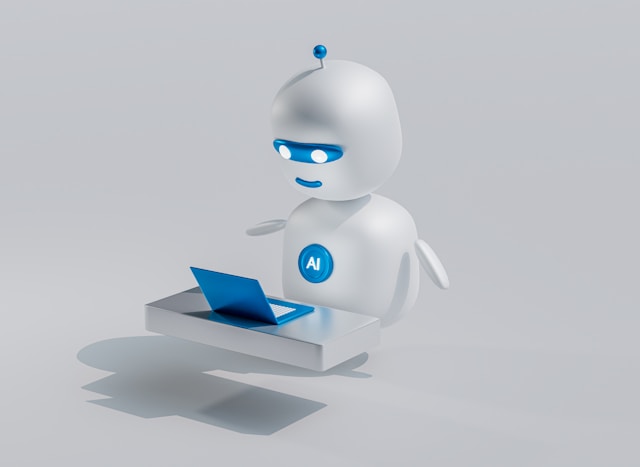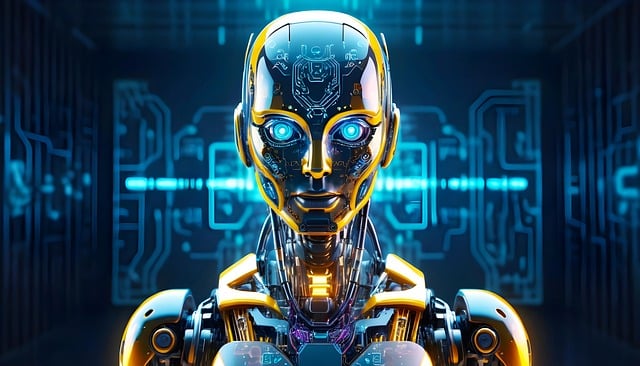Artificial Intelligence (AI) has significantly transformed various sectors, including the creative industries. AI’s integration has transformed the landscape of creativity, from music and visual arts to writing and filmmaking. This blog aims to provide a historical perspective on the role of AI in creative fields, exploring its evolution and current impact. Understanding AI’s capabilities for freelance writers can open up new opportunities and boost productivity. Most importantly, it can inspire new levels of creativity, ushering in an exciting era of innovation.
Early Developments in the Role of AI and Creativity
The origins of AI, a concept that has significantly transformed various sectors, including the creative industries, can be traced back to the mid-20th century. Pioneers like Alan Turing began exploring the idea of machine intelligence. They laid the foundation for understanding how machines could exhibit intelligent behavior. Early applications of AI were primarily in computing and automation, focused on solving mathematical problems and performing repetitive tasks efficiently. These early developments set the stage for the significant advancements in AI that would follow. Ultimately, they transform how we understand and utilize AI in creative industries.
Significant breakthroughs marked the emergence of AI in creative endeavors. One of AI’s earliest and most notable uses in creative processes was in music composition. The Illiac Suite, a project created in 1956 by Lejaren Hiller and Leonard Isaacson, was a pioneering demonstration of AI’s potential to compose music (Berbey, 2017). This project was among the first to utilize a computer for generating a musical score. It proved that machines could play a role in creating art.
In visual arts, Harold Cohen’s AARON, developed in 1973, marked a milestone in generative art (Garcia, 2016). AARON was a computer program designed to produce original artwork. Cohen’s work with AARON highlighted how AI could create intricate visual pieces. It pushed the boundaries of what was possible with technology at the time.
Text generation also saw early developments with systems like ELIZA, created in 1966 by Joseph Weizenbaum (Rossen, 2023). ELIZA mimicked human conversation using pattern matching and substitution methodologies. It laid the groundwork for future natural language processing (NLP) advancements. ELIZA’s ability to simulate dialogue with humans was a breakthrough, showing that machines could engage in essential conversational exchanges.
Despite these early successes, the AI systems of the time were not without their limitations. The era’s limited processing power and rudimentary algorithms constrained the complexity and depth of AI’s creative outputs. For instance, the music composed by early AI often lacked the emotional depth found in human-created music. Similarly, while impressive, the art generated by AARON could not match the nuanced creativity of human artists. These limitations underscore the ongoing challenge of imbuing AI with the depth and complexity of human creativity.
Ethical concerns also emerged during this period, particularly regarding the originality and authenticity of AI-generated content. Debates have been intense about who holds the rights to AI-created works and whether these creations can be deemed genuine art. These discussions laid the groundwork for ongoing debates about AI and creativity that continue today. The issues of originality, authenticity, and the rights to AI-generated works are complex and continue to be debated, highlighting the need for clear ethical guidelines in using AI in creative fields.
These early developments set the stage for the significant advancements in AI that would follow, ultimately transforming how we understand and utilize AI in creative industries. As AI technology evolved, so did its applications in various creative fields, leading to the sophisticated tools and systems we have today.
The Evolution and Role of AI in Creative Industries
Advancements in AI technology over the past few decades have dramatically expanded its capabilities in creative industries. Machine learning and neural networks have enabled more sophisticated and nuanced creative outputs. Natural Language Processing (NLP) advancements, exemplified by OpenAI’s GPT series, have revolutionized text generation, allowing AI to produce coherent and contextually relevant content. These advancements have revolutionized content creation, enabling writers to produce high-quality text quickly and efficiently.
In visual arts, the role of AI was to facilitate digital art creation and AI-assisted design. Tools like DeepArt and MidJourney enable artists to generate stunning visuals by blending styles and creating new art forms. AI’s influence extends to the film and animation industries, where AI-driven special effects, digital re-aging of actors, and automated editing processes have significantly enhanced production quality and efficiency. AI algorithms can perform tasks like color correction, sound editing, and even generating realistic CGI, streamlining the labor-intensive aspects of film production and allowing creators to focus more on the artistic elements of their work.
The literary arts have also seen significant changes with AI-driven writing tools. Automated storytelling and content creation for marketing and media are now commonplace. IBM’s Watson, for example, has been used in music and film to analyze data and predict trends, offering insights that help creators tailor their content to audience preferences. OpenAI’s GPT-3 has demonstrated impressive capabilities in generating human-like text, aiding writers in brainstorming and drafting content. This has benefited freelance writers, who can leverage these tools to enhance their productivity and creativity.
The evolution of AI in creative industries has made the creative process more efficient and opened up new possibilities for innovation. By automating routine tasks and providing new sources of inspiration, AI empowers creators to push the boundaries of their work and explore new artistic horizons.
The Impact of AI on Freelance Writing

For freelance writers, AI offers numerous tools and platforms to enhance their work in multiple ways. AI-driven content creation tools like Jasper and Grammarly assist in generating ideas, improving grammar, and refining style. Jasper, for instance, can help brainstorm topics, draft outlines, and even write complete articles. It provides a solid starting point that saves considerable time. Conversely, Grammarly perfects the text by catching grammatical errors, suggesting stylistic improvements, and ensuring clarity and conciseness.
These tools significantly save time on research and editing, allowing writers to focus more on the creative aspects of their projects. By automating routine tasks, AI will enable writers to delve deeper into their work’s narrative, tone, and style, enhancing their overall output. This increased productivity and efficiency are significant benefits of using AI in freelance writing. Writers can generate content quickly and consistently, providing a solid foundation to build and refine. The expanded creative possibilities enable writers to explore new genres and styles, pushing the boundaries of their creativity and discovering new ways to engage their audience. AI offers numerous benefits to freelance writers, such as saving time on routine tasks, expanding creative possibilities, and pushing the boundaries of creativity.
However, potential challenges exist. Maintaining originality and authenticity in AI-generated content is crucial. While AI can produce coherent and contextually appropriate text, it lacks the human touch and unique voice vital for engaging content. Writers must ensure AI tools enhance rather than replace their creativity, infusing their style and insights into the final piece. This commitment to authenticity is vital to responsible writing in the AI era. Ethical concerns also arise, particularly regarding data privacy, copyright infringement, and bias in AI algorithms. Freelance writers must navigate these issues carefully, ensuring that their use of AI is both responsible and transparent.
By effectively leveraging AI tools, freelance writers can significantly enhance their productivity and creativity while addressing the challenges of maintaining their work’s authenticity and ethical standards. This balanced approach can lead to more innovative and engaging writing, paving the way for a successful freelance career.
Future Trends and Opportunities on the Role of AI

Looking ahead, emerging technologies in AI promise to revolutionize creative industries further. AI will revolutionize virtual reality (VR) and augmented reality (AR) by creating immersive experiences that seamlessly integrate digital and physical worlds. For example, AI can generate dynamic, responsive virtual environments and realistic avatars, adapting in real time based on user behavior and input. This integration creates highly personalized and engaging experiences that were previously unthinkable, pushing the boundaries of what’s possible in entertainment and interactive media.
The role of AI is to help shape the future of creative content through personalization. AI can tailor experiences to individual preferences by analyzing user data, making content more engaging and relevant. This capability allows customized music playlists, personalized news articles, and bespoke clothing designs, enhancing user satisfaction and loyalty.
In the future, AI will likely become an integral part of freelance writers’ daily workflows. Tools that leverage AI for content generation, editing, and research will streamline the writing process. These tools enable writers to focus more on creativity and less on routine tasks. Collaboration between humans and AI will lead to innovative forms of creative expression where AI can inspire and generate ideas that writers might not have considered otherwise.
To prepare for this future, freelance writers should develop skills to leverage AI tools effectively. This includes comprehending the abilities and constraints of different AI applications and staying updated with technological advancements. By embracing AI, writers can enhance their productivity and creativity, opening up new storytelling and content creation avenues. Furthermore, staying informed about ethical considerations and best practices for using AI will ensure that writers maintain the integrity and originality of their work.
AI’s future in creative industries shines with boundless opportunities for innovation and collaboration. As technology advances, those who adapt and utilize these tools will lead the new era of creativity.
Final Thoughts
AI has played a transformative role in creative industries, evolving from simple automation to sophisticated content generation. For freelance writers, AI presents exciting opportunities to enhance creativity and productivity. By embracing AI as a tool and exploring its potential, writers can push the boundaries of their craft and stay ahead in a rapidly changing landscape. AI will significantly transform creative industries, offering countless opportunities for innovation and collaboration.
References
Berbey, J. (2017, February 10). 62 years later, electronic music still created at University. The Daily Illini. https://dailyillini.com/news-stories/2017/02/10/62-years-later-electronic-music-still-created-university/
Garcia, C. (2016, August 23). Harold Cohen and AARON—A 40-Year Collaboration. Computer History Museum. https://computerhistory.org/blog/harold-cohen-and-aaron-a-40-year-collaboration/
Rossen, J. (2023, February 14). ‘Please Tell Me Your Problem’: Remembering ELIZA, the Pioneering ’60s Chatbot. Mental Floss. https://www.mentalfloss.com/posts/eliza-chatbot-history

